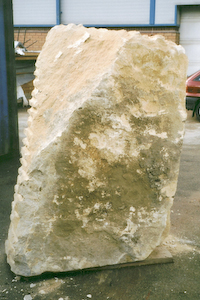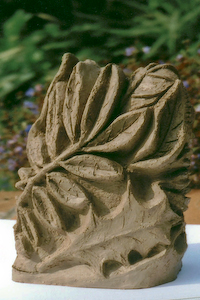|

Two tonne block of
Ancaster before carving Leaves of the Forest. |
He obtains his
stone either direct from the quarry as specific sized blocks or as
off-cuts which might otherwise go to landfill.
His
sculpture group, the Shapeshifters Sculpture Company, has also
sourced good quality limestone from buildings about to be
refurbished e.g. the Leicester City Police Station where some of the
stone was not required in the new building and was surplus and can
be re-carved.
The other
source of stone is to buy from a stone dealer and Viv uses Nigel
Owen (www.nigelowenstone.co.uk)
of Yelvertoft, Northamptonshire.
|

One of the clay maquettes for
Leaves of the Forest. |

